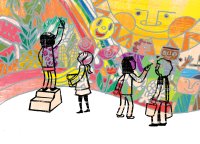Transforming a School Through Arts Integration
Structuring a school around the arts can help students excel academically and develop social and emotional skills.
Your content has been saved!
Go to My Saved Content.Nearly a decade ago, poor test scores and low enrollment put Washington Elementary, a high-poverty school in Alameda, California, at risk for closure. But a group of committed parents and teachers pushed the district to keep the school open with a pledge to “build a school centered around art,” writes Katrina Schwartz, who visited the school for her story “How Art Can Help Center a Student’s Learning Experience” in KQED’s Mindshift.
Now known as Maya Lin Elementary, the school’s newfound emphasis on art comes in the wake of the No Child Left Behind Act, which pushed many U.S. school systems to neglect enrichment classes and place a greater emphasis on testable subjects like math and English language arts (ELA). Yet schools like Maya Lin are “starting to realize the folly of these practices,” reports Schwartz, and are increasingly offering art, not as a separate course, but as a way to teach academic content—an approach that research shows can boost students’ learning and well-being.
“The arts provide an access point for everyone,” Caitlin Gordon, a Maya Lin third grade teacher, told Schwartz. “I think it allows children to learn about how the process of something is just as important, if not more important, than the product. I think it just really helps create more of that well-balanced, critical-thinking person that we want for our future.”
Teachers like Gordon work hand-in-hand with art instructors to devise lessons that integrate art into every element of the school day, including subjects like math and English. For a project on climate change, for example, teachers used aspects of the artistic process to teach science, ELA, and social studies content, while helping students build social and emotional skills like creativity, communication, and resilience.
Schwartz spoke with one student, John, who created a painted model to show the greenhouse effect. Though he experienced some “setbacks” artistically, he became more resilient by persisting and iterating in his creative process, Schwartz says.
Maya Lin students also regularly respond to their peers’ creations through a technique called “the ladder of feedback” where “partners take turns presenting their work, getting positive and negative feedback from a partner, and thinking through how they plan to incorporate the feedback.” Their dialogue is framed around the eight studio habits of mind, principles like “envision” and “observe” that can guide the artistic process. Students are encouraged to use these methods, not only in the creation of artwork, but in their interactions with their teachers and each other.
To Schwartz, the approach at Maya Lin not only makes “learning fun, multi-disciplinary, connected and creative,” it also “gives students a way to think about the world differently, to make connections, and to contemplate their place within it....habits that they’ll use no matter what they go on to do.”
